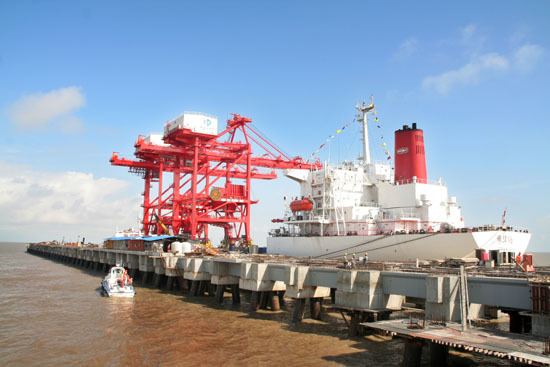Prefecture-level city Yancheng Area 3,059 km² Province Jiangsu | Time zone China Standard (UTC+8) Local time Thursday 3:27 AM | |
 | ||
Country People's Republic of China Weather 2°C, Wind W at 10 km/h, 55% Humidity Points of interest Dafeng Milu National Nature Reserve of Jiangsu, China | ||
Dafeng (simplified Chinese: 大丰; traditional Chinese: 大豐; pinyin: Dàfēng) is a coastal district under the administration of Yancheng, Jiangsu province, China. Located on the Jiangsu North Plain with a coastline of 112 km (70 mi), Dafeng was historically one of the largest salt-making areas in China and now is famed for its well preserved eco-system and numerous national conservation parks. The district has the largest national nature reserve for a rare deer species, Père David's Deer or Milu (麋鹿) in Chinese. It borders the prefecture-level city of Taizhou to the southwest.
Contents
- Map of Dafeng Yancheng Jiangsu China
- Administration and jurisdiction
- Area and population
- Economy industry and environment
- Culture and folklore
- Transportation and tourism
- Education
- Notable personage
- References
Map of Dafeng, Yancheng, Jiangsu, China
Administration and jurisdiction
Under the jurisdiction of Yancheng, Dafeng comprises 12 towns and townships and two provincial economical zones.
Area and population
Dafeng occupies a physical land mass of 2,370 km2 (920 sq mi) and the district’s population is 0.7 million. In order to boost its economic development, the district contracts the government of Shanghai and Jiangsu provincial government in which the district rents out a part of its coastal territory to two governments in exchange for more investment and cooperation.
Economy, industry, and environment
Traditionally, Dafeng heavily depended on its agriculture income and its principal agricultural products include rice, cotton, oil seed, cocoon, fruit, livestock and aquatic products. In 2006, its agricultural earning occupied half of the total GDP of the district.
The district has been designated by the national government as one of ecology-pioneering cities and a comprehensive experimental zone in China. Its industrial sectors, including machinery, foods, light and chemical industries, have been developing in a good shape and fast. The incoming investment funds are further improving the district’s economic capability.
Dafeng Port is a sea-orientated port and has been listed by the state government as one of important ports in the east coastline of China. The district has been included in the Shanghai Economical Zone and the Yangtze Delta Economical Circle.
Regardless of its success in rapid industrial growth, Dafeng still emphasizes its eco-balanced development. The district drafted the first comprehensive protocol in China to highlight its ecologic priority in the district’s development scheme and has been selected by the Food and Agriculture Organization of the United Nations as an experimental area of the Sustainable Agriculture and Rural Development program. In addition, the district has been working hard to establish its national reputation in produce of diverse organic food, vegetables, fruits, etc.
Dafeng maintains the largest national nature reserve for the unpolluted wetland in China and the reserve has been recognized as a fabulous conservation land for an endangered deer species, Père David's Deer or Milu (麋鹿) in Chinese. The wild deer perished in the early 19th century in China but was re-introduced to the national park in 1985. The immense coastline and wetland is a paradise as well for other species of insects, fish, animals, and millions of migrating birds.
Culture and folklore
Early settlers of Dafeng were migrants from either the north of and the south. While the north migrants were from the neighboring areas, those from the south had their ancestry in the south of Yangtze River. In early days, the two migrant groups primarily lived in their respective communities and that forms the foundation of today’s two distinct dialects. The local dialect (also known as Benchang dialect, 本场话) and the Haimen dialect (海门话). The local dialect is a version of the language popular in the northern China—north of Yangtze River. The Haimen dialect is overwhelmingly popular in Haimen county (Jiangsu province), which is a version of Wu language that is whidespread in the southern Jiangsu and Zhejiang provinces. Nowadays, with frequent and much easier travel and communications, the spoken language (dialect) diversity has been diminishing and a mixture of the two (dialect) vocabularies and accents has gradually takes its form.
Transportation and tourism
Dafeng has an hour of driving distance to its neighbors including Yancheng, Dongtai, Sheyang and Xinghua, about three hours to the provincial capital, Nanjing, and two hours to Shanghai. The district is connected by railways and highways, plus recently constructed expressways. For air passengers, Nanjing Lukou International Airport and Yancheng Airport are two options. Upon completion of Sutong Bridge, Shanghai and the southern Jiangsu would be accessible within two hours of driving distance.
Dafeng Port is a sea-orientated cargo port and has been listed by the national government as one of important port in the middle of the east coastline of China. It handles ocean-going vessels and containers to or from South Korea, Japan and Hong Kong.
In the inner district, the public transportation including bus, taxi and cargo transport, long distance buses to near cities or towns, provides convenience to commuters and visitors even if the system still needs a major improvement.
Dafeng is one of 15 eco-orientated touring cities in China, designated by the central government. Over years, the district has been becoming an attractive tourist paradise for its marvelous natural resources including the reservation parks and the diverted wildlife.
Education
Dafeng has well instituted compulsory primary education system. The secondary schools including high schools achieves significant graduate rate. Dafeng does not have higher learning institutions available in the district.
Notable personage
Shi Naian (施耐庵), a most well-known novelist in China’ history, attributed the first compiler of the famous novel, The Water Margin (水浒传).
Zhang Jian (张謇), a founder of China’s modern textile industry and a prominent statesman, once established the Dafeng Salt Exploitation Limited in 1917.
